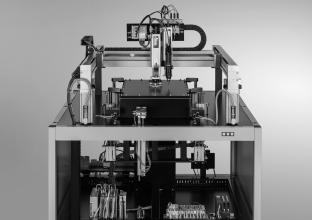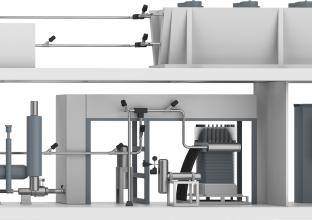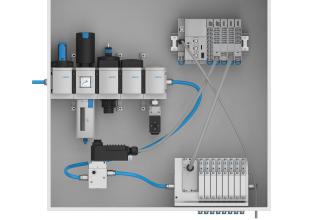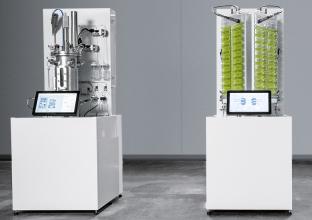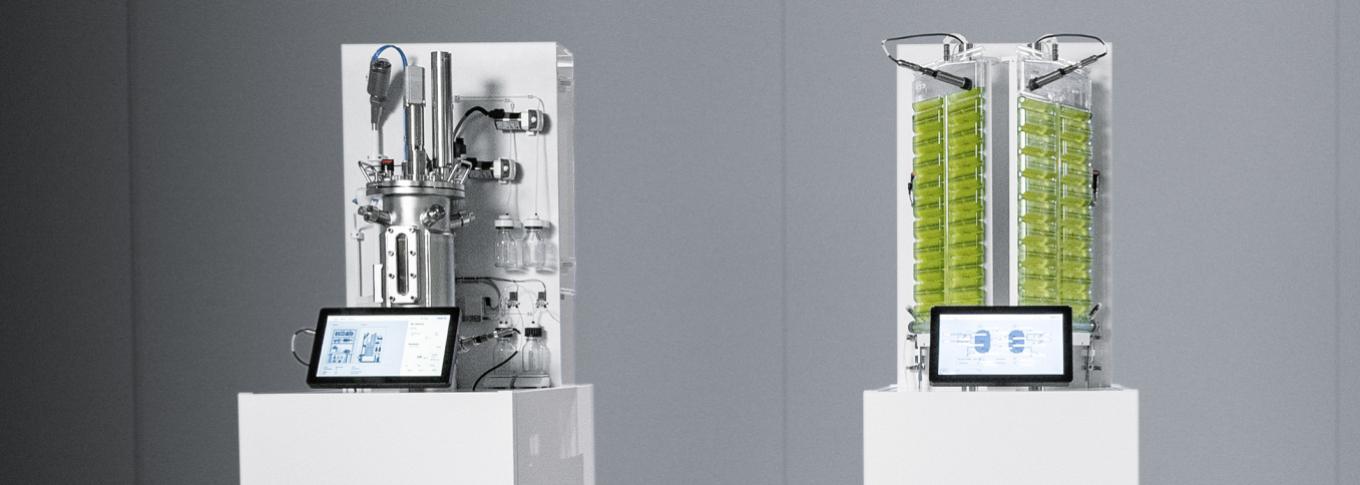
The industrial transformation takes off with automation
How can the industrial transformation be achieved at an acceptable cost? What ecological innovations can industry expect in the coming years? Automation provides answers to these questions. Festo has come up with many solutions for electromobility, green hydrogen and bioreactors.
The industrial transformation is currently most evident in electromobility. But what actually happens to batteries at the end of their life cycle? After around 15,000 charging cycles, the question of recycling the materials they contain arises. By 2025, an estimated 600,000 tons of used batteries will be ready for recycling. Only automation makes it possible to manage the dismantling and recycling process economically. Festo already has a portfolio of solutions for the clean and economical dismantling and recycling of used batteries.
Fully automated mechanical disassembly
In the first step of the battery recycling process, the packs are mechanically dismantled into modules, battery cells and other components. In recycling plants, for example, space-saving gantries with electric and pneumatic axes from Festo are in operation. These space gantries offer the necessary flexibility, as the batteries are designed differently depending on the manufacturer and vehicle model.
This mechanical disassembly is fully automatic. As a rule, four steps are necessary: First, the cooling circuit is checked and then the adhesive bead is cut open, which serves as a sealing compound between the upper and lower parts of the housing. Linear swing clamps then reliably fix the upper part of the housing in place. In the final step, the upper part of the housing is lifted. Vacuum suction cups are used here.
Recycling rare minerals
Most electric vehicles run on lithium-ion batteries. If these are not disposed of properly at the end of their life cycle, they are dangerous for people and the environment. The EU Battery Directive stipulates that batteries must be reused, reconditioned or recycled at the end of their life. The recycling process is based on a chemical precipitation method using acid. This recovers rare minerals from the black mass as metal salt. The battery manufacturers receive the metal salt for the production of new batteries.
Various Festo process automation components are used in a recycling plant for this purpose, such as angle seat valves that reliably shut off gaseous or liquid media in piping systems. Butterfly valve units meter the fluid flows precisely. Robust and corrosion-resistant linear actuators are available for actuating process valves such as knife gate and knife gate valves or valves without housings. The classic modular valve terminal with CPX-MPA electrical terminal is ideal for decentralized automation solutions.
Green hydrogen
Hydrogen will play a key role in the future energy landscape and in the decarbonization of energy-intensive industries such as the chemical, steel and cement industries. Many safety requirements must be taken into account in production and infrastructure. Depending on the type and nature of production, centralized and/or decentralized automation concepts, space-saving control cabinet solutions or modular concepts can be considered. At our stand, we will show a broad portfolio that supports the industrial transformation of the energy sector with the right technological innovations.
Safe hydrogen production with electrolysis
The electrolyzer is the central element along the hydrogen value chain. Electrolysis with sustainable electricity is already used today as an established technology to produce hydrogen with zero emissions. An electrolyzer uses products that are certified for SIL and global use in hazardous areas. These include robust and corrosion-resistant VOFC solenoid valves, as well as the VTUG valve terminal with 48 valve functions per valve terminal. Festo will show products at the Hannover Messe that cover the specifics of hydrogen production.
Customized and ready to install
Enclosures that precisely meet the respective specifications protect components against environmental influences and foreign bodies. Regardless of whether pneumatic, electrical or electro-pneumatic components are involved, the end result is a ready-made control cabinet that is precisely adapted to the respective application. On request, Festo can also subject the entire control cabinet to a SIL assessment. For applications in potentially explosive atmospheres, control cabinets can be designed, assembled and certified in accordance with international and regional standards.
BioTech Automation: Products and solutions for bioreactors
Bioprocesses are becoming increasingly important for industry, as they offer sustainable alternatives to conventionally manufactured products. Festo's product portfolio is already able to serve the growing biologization market in many areas, particularly in gassing, liquid handling and the integrated automation of bioreactors. At the Hannover Messe, Festo will be demonstrating how selected cultivation processes can be achieved with over thirty automation technology catalog products. The next two paragraphs provide an overview of the most important automation products in use.
Highlight products Algae reactor
Photosynthesis is a central metabolic pathway for the growth of algae. To enable this, gases must be injected in a controlled manner. There are two options for gassing: On the one hand, a VEMD mass flow controller for air and CO2 is used to deliver exactly the right amount into the reactor. On the other hand, gassing is shown using a pressure regulator in conjunction with a flow sensor. A pneumatically driven pinch valve is responsible for handling liquids, i.e. filling and emptying the reactor or taking samples. These valves are controlled automatically with the new VTUX valve terminals. VTUX – one of the highlights at our stand – is an "open architecture solution" that bridges the gap between electrical and pneumatic automation in one system. It sets new standards in terms of modularity and flexibility.
Highlight products Bioreactor with E. coli
Mass flow controllers are also used here for the correct dosing of gases such as nitrogen, CO2 and oxygen. The Pressure Over Liquid process is used for dosing liquid media such as nutrients, acids and alkalis. A proportional pressure control valve is used to apply a pre-pressure to a media container. The excess pressure causes the medium to enter the reactor. The media-separated solenoid valve VYKA controls even the smallest quantities of liquid with high precision.
A ball valve unit is used to control the temperature of the bioreactor through the double jacket so that the desired temperature is reached in the bioreactor. The CPX-E control system is used as the control system in both reactors. This enables precise control of the pH value, temperature, gassing and light.
费斯托 (Festo)是一家全球性的独立的家族企业,总部位于德国埃斯林根。自成立以来,Festo在工业自动化技术和技术教育方面制定标准,从而为环境、经济和社会的可持续发展做出贡献。公司为超过35个行业的30万家工厂和过程自动化客户提供气动和电驱动自动化技术解决方案,其中生命科学和实验室自动化业务受到越来越多的关注。Festo产品和服务遍布176个国家。2024年,费斯托在全球61个国家的250多个分支机构拥有约20600名员工,实现销售额34.5亿欧元。每年约8%的销售额用于研发。在这家学习型企业,1.5%的销售额用于基础和进一步培训。Festo 教学培训 (Didactic SE) 是全球领先的技术教育和培训供应商,为全球客户提供工业环境中全面的数字化和常规学习解决方案。

